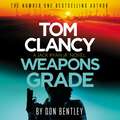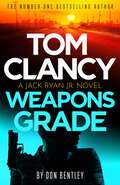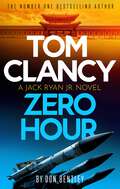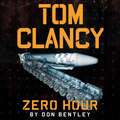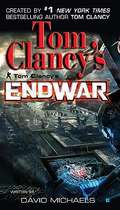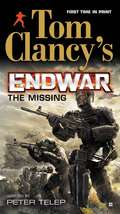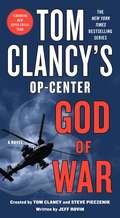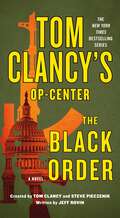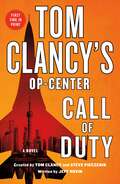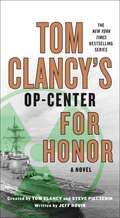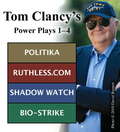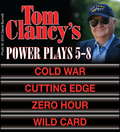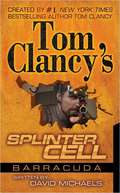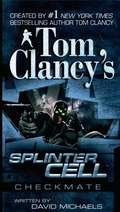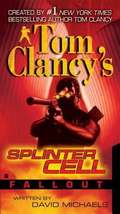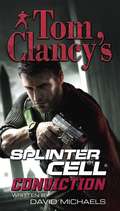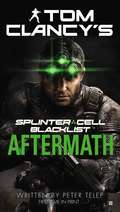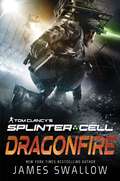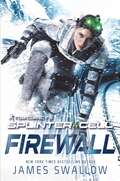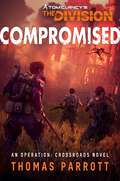- Table View
- List View
Tom Clancy Weapons Grade: A breathless race-against-time Jack Ryan, Jr. thriller (Jack Ryan, Jr. #11)
by Don BentleyThe aftermath of a shocking crime sends Jack Ryan, Jr. down a path that leads to international destruction in the latest entry in this #1 New York Times bestselling series. The quiet of a Texas night is shattered by the sounds of screeching brakes, crumpling metal and, most shockingly, rapid gunfire. The auto accident Jack Ryan, Jr. thought he witnessed turned out to be a professional hit. Jack may be too late to save the victim, but he'll be damned if he's going to let the hitters escape justice. He's got just one lead - a meeting the victim was going to. When Jack shows up instead, he's drawn into the seedy underbelly of a small Texas town and the cold case of a college student who vanished from its streets. Jack is left with nothing but questions. Who wants it to look like the victim was drunk? Why does someone want an innocent witness killed? And most of all, what's a team of South African hitmen doing in the Lone Star State?His quest for answers will take Jack from a quiet Texas road to the middle of an international conspiracy - and may just cost him his life.
Tom Clancy Weapons Grade: A breathless race-against-time Jack Ryan, Jr. thriller (Jack Ryan, Jr. #11)
by Don BentleyThe aftermath of a shocking crime sends Jack Ryan, Jr. down a path that leads to international destruction in the latest entry in this #1 New York Times bestselling series. The quiet of a Texas night is shattered by the sounds of screeching brakes, crumpling metal and, most shockingly, rapid gunfire. The auto accident Jack Ryan, Jr. thought he witnessed turned out to be a professional hit. Jack may be too late to save the victim, but he'll be damned if he's going to let the hitters escape justice. He's got just one lead - a meeting the victim was going to. When Jack shows up instead, he's drawn into the seedy underbelly of a small Texas town and the cold case of a college student who vanished from its streets. Jack is left with nothing but questions. Who wants it to look like the victim was drunk? Why does someone want an innocent witness killed? And most of all, what's a team of South African hitmen doing in the Lone Star State?His quest for answers will take Jack from a quiet Texas road to the middle of an international conspiracy - and may just cost him his life.
Tom Clancy Zero Hour (Jack Ryan, Jr. #9)
by Don BentleyJack Ryan, Jr. is the one man who can prevent a second Korean War in the latest thrilling entry in the #1 New York Times bestselling series.When the leader of North Korea is catastrophically injured, his incapacitation inadvertently triggers a "dead-man's switch," activating an army of sleeper agents in South Korea and precipitating a struggle for succession.Jack Ryan, Jr. is in Seoul to interview a potential addition to the Campus. But his benign trip takes a deadly turn when a wave of violence perpetrated by North Korean operatives grips South Korea's capital. A mysterious voice from North Korea offers Jack a way to stop the peninsula's rush to war, but her price may be more than he can afford to pay.
Tom Clancy Zero Hour (Jack Ryan, Jr. #9)
by Don BentleyJack Ryan, Jr. is the one man who can prevent a second Korean War in the latest thrilling entry in the #1 New York Times bestselling series.When the leader of North Korea is catastrophically injured, his incapacitation inadvertently triggers a "dead-man's switch," activating an army of sleeper agents in South Korea and precipitating a struggle for succession.Jack Ryan, Jr. is in Seoul to interview a potential addition to the Campus. But his benign trip takes a deadly turn when a wave of violence perpetrated by North Korean operatives grips South Korea's capital. A mysterious voice from North Korea offers Jack a way to stop the peninsula's rush to war, but her price may be more than he can afford to pay.
Tom Clancy's EndWar #1
by David MichaelsBased on the bestselling video game, this new series will take readers onto the battlefields of World War III with the technical savvy and explosive action that Clancy fans have come to expect.
Tom Clancy's EndWar #2: The Hunted
by David MichaelsShe's known as the Snow Maiden--an operative of a secret group dedicated to world domination. To get their hands on her, U.S. Special Forces Captain Alexander Brent and his team will have to outmaneuver a terrorist faction bent on wiping her off the face of the earth.
Tom Clancy's EndWar: The Missing
by Tom Clancy Peter TelepAfter a devastating nuclear exchange in the Middle East, America and Russia stand on opposite sides in the quest for the world’s resources. While on a recon mission over Russia, Joint Strike Force pilot Major Stephanie Halverson tests a revolutionary new radar device—until she is shot down. In the jungles of Ecuador, relentless Marine Raider Captain Mikhail “Lex” Alexandrov pursues a wanted terrorist—and stumbles on an international conspiracy that will take him and his team into battle. On an island off Japan, a former Russian spy is hunted by her comrades, and her only way out could be to defect to the West.Each of their fates intertwines with a deadly cabal thought to have been destroyed, but it was only wounded. And now it has returned—stronger than ever…Based on Ubisoft’s bestselling game, Tom Clancy’s EndWar®
Tom Clancy's Ghost Recon
by David MichaelsMore stealthy and deadly than the Army's Special Forces, the Ghost Recon team infiltrates China's eastern coast to seek and destroy the Spring Tiger Group, a small band of renegade Chinese leaders.
Tom Clancy's Op-Center: A Novel (Tom Clancy's Op-Center #19)
by Jeff RovinIn Tom Clancy's Op-Center: God of War, after the devastating outbreak of a killer super virus, the Black Wasp Team must prevent America's enemies from gaining access to the most dangerous weapon the world has ever seen.The passengers and crew on an Airbus en route to Australia suddenly begin coughing up blood and hemorrhaging violently as the plane plunges to the ground. There are no survivors.A luxury yacht in the South Indian Sea blows up, and a lone woman escapes the contagion that has inexplicably killed everyone else on the boat.A helicopter whose occupants have been stricken by an unknown illness crashes into a bridge in South Africa, killing motorists and pedestrians.The world is facing a devastating bio-terror event, and a game of brinksmanship gets underway as the major powers jockey for position: China sends a naval flotilla to seek the source of the plague and find a way to weaponize it, while Russia maneuvers quietly on the sidelines to seize the deadly prize in its quest to regain an empire. Back in Washington D.C., Chase Williams and his top-secret Black Wasp special ops team must find out who is behind these deadly attacks before war is unleashed—and millions of innocent lives are lost.
Tom Clancy's Op-Center: A Novel (Tom Clancy's Op-Center #20)
by Jeff RovinIn a plot ripped from today's headlines, America’s elite task force must take down a group of ruthless domestic terrorists determined to paralyze the country through extreme acts of violence in this action-packed new thriller in the bestselling Tom Clancy's Op-Center series. They are known as the Black Order. Self-proclaimed patriots and survivalists, they refuse to surrender their values and beliefs to the left-leaning cultural and progressive forces threatening their nation. Military veterans and high-tech specialists, they’ve begun a savage war which includes public assassinations of politicians and celebrities and high-profile bombings, striking without warning or mercy. The Black Order wants nothing less than complete capitulation by the US government, giving them free rein to make their ideologies the law of the land.Only Op-Center’s Black Wasp, a skilled team of military operatives answerable to the President, can defeat these militant revolutionaries. But even as Admiral Chase Williams and his agents force them on the run, the Black Order possesses a weapon of mass destruction that they will not hesitate to unleash against millions of innocent civilians.
Tom Clancy's Op-Center: A Novel (Tom Clancy's Op-Center #22)
by Jeff RovinAs fears of a dangerous nuclear confrontation between China and the US escalate, China targets individual members of the Black Wasp team in this heart-pounding entry in the bestselling series.After successfully extricating one of Beijing’s top scientists from captivity and escorting him to America, the Black Wasp commandos find themselves targeted by Chinese assassins. The killers are not only highly trained but invisible, launching tactical strikes from multiple embassies in Washington, D.C. The Chinese squad has also infiltrated American intelligence and is aware of every move Black Wasp makes. Complicating matters, the new president of the United States seems willing to let Op Center take the fall for the mission that precipitated the crisis. The shocking murder of one of their own forces the surviving team members to seek both a safe haven and an ally in the fight for survival -- an unexpected partner who might, in fact, be part of the problem.
Tom Clancy's Op-Center: A Novel (Tom Clancy's Op-Center)
by Jeff RovinIn this race-to-the-finish thriller in the bestselling Tom Clancy's Op-Center series, an attempt to exfiltrate a Chinese scientist threatens to incite war between China and the United States.When the launch of their powerful new hypersonic missile ends in destruction, the Chinese government needs someone to blame. Was it a failure of engineering, or sabotage? The chief engineer on the project, Dr. Yang Dàyóu, is targeted as the scapegoat and arrested—unable to help his family as they are hunted down by the military.Op-Center’s Lt. Grace Lee is sent to China on a solo reconnaissance mission, but when she sees an opportunity to free the imprisoned scientist, she seizes it. With Lt. Lee on the run and the Chinese military at her heels, Director Chase Williams sends the rest of Op-Center to Mongolia as an extraction team. Meanwhile, Dr. Dàyóu’s son has aligned himself with a dangerous group of counterrevolutionaries hellbent on dismantling the Communist regime, putting his father’s life—and his own—in jeopardy. The Black Wasp team races to rescue their colleague and her high-risk companion without setting off an international incident that could leave China ready to release their greatest weapon yet.
Tom Clancy's Op-Center: Fallout (Tom Clancy's Op-center Ser. #22)
by Tom ClancyAs fears of a dangerous nuclear confrontation between China and the US escalate, China targets individual members of the Black Wasp team in this heart-pounding entry in the bestselling series. After successfully extricating one of Beijing’s top scientists from captivity and escorting him to America, the Black Wasp commandos find themselves targeted by Chinese assassins. The killers are not only highly trained but invisible, launching tactical strikes from multiple embassies in Washington, D.C. The Chinese squad has also infiltrated American intelligence and is aware of every move Black Wasp makes. Complicating matters, the new president of the United States seems willing to let Op Center take the fall for the mission that precipitated the crisis. The shocking murder of one of their own forces the surviving team members to seek both a safe haven and an ally in the fight for survival - an unexpected partner who might, in fact, be part of the problem.
Tom Clancy's Op-Center: For Honor (Tom Clancy's Op-Center #17)
by Jeff RovinIn For Honor, a chilling new thriller in the New York Times bestselling Tom Clancy's Op-Center series, simmering tensions threaten to ignite when a silo of Cold War missiles surfaces in the Middle East.In 1962, at the height of the Cold War, the Soviet Union sent a convoy of nuclear missiles to Cuba. The crisis that followed almost triggered World War III. However, while all eyes were on the Caribbean, not all of the missiles were sent to Cuba. Several ships slipped from the flotilla and headed for a fishing village in a remote, frigid, northeastern Soviet frontier. There, a silo was constructed not far from Alaska.More than sixty years later, that silo and its lethal contents are intact. Now, Iranian scientists team with a Russian agent and his estranged, arms-smuggling father to bring those missiles to Tehran. When an intel officer at Op Center starts picking up hints of the deal, the government’s off-the-grid unit must track the unknown actors – and try to decide whether they can count on data provided by an Iranian defector, a man who has more at stake than anyone realizes.At the same time, Op-Center sends a lone agent to Havana to try and find an aging revolutionary, a woman, who may hold the key to pinpointing the location of the silo. Complicating matters is a turf war between Op Center, the White House, and the FBI that threatens to compromise the investigation…as the time to act grows perilously short.
Tom Clancy's Op-Center: God of War (Tom Clancy's Op-center Ser. #19)
by Tom Clancy Steve PieczenikIn Tom Clancy's Op-Center: God of War, after the devastating outbreak of a killer super virus, the Black Wasp Team must prevent America's enemies from gaining access to the most dangerous weapon the world has ever seen. The passengers and crew on an Airbus en route to Australia suddenly begin coughing up blood and hemorrhaging violently as the plane plunges to the ground. There are no survivors. A luxury yacht in the South Indian Sea blows up, and a lone woman escapes the contagion that has inexplicably killed everyone else on the boat. A helicopter whose occupants have been stricken by an unknown illness crashes into a bridge in South Africa, killing motorists and pedestrians. The world is facing a devastating bio-terror event, and a game of brinksmanship gets underway as the major powers jockey for position: China sends a naval flotilla to seek the source of the plague and find a way to weaponize it, while Russia maneuvers quietly on the sidelines to seize the deadly prize in its quest to regain an empire. Back in Washington D.C., Chase Williams and his top-secret Black Wasp special ops team must find out who is behind these deadly attacks before war is unleashed--and millions of innocent lives are lost.
Tom Clancy's Power Plays 1 - 4
by Tom ClancyUpLink Technologies' innovations keep America's defense and intelligence forces at the cutting edge. And the visionary behind UpLink is Roger Gordian, as astute about the battlefield as he is about the boardroom...
Tom Clancy's Power Plays 5 - 8
by Tom ClancyWhen it comes to high-tech intelligence systems, UpLink Technologies is the leader in the field--and sometimes, the nation's best hope in a time of crisis. Four novels in the series created by #1 New York Times master of the techno-thriller! <P> Cold War <P> Cutting Edge <P>Zero Hour <P>Wild Card
Tom Clancy's Splinter Cell #3: Checkmate
by David MichaelsFew know he exists. But when millions of Americans lives are at state, Third Echelon special operative Sam Fisher is the man to depend on. He handles covert missions either too sensitive or too risky for even the CIA or FBI. And he operates alone. Fisher is called off of a training exercise to intercept a cargo freighter loaded down with radioactive material and heading straight for the U.S. coast. He has minutes to disable the ship--or die trying. While he races to beat the clock, another attack has hit its target. As the residents of a small town in New Mexico start dying of radiation poisoning, Fisher weaves through a tangled web of clues to find the mastermind behind the strikes: one of the greatest enemies of the free world...
Tom Clancy's Splinter Cell #4: Fallout
by David MichaelsSam's brother is found dying of radiation poisoning, and Sam must find out why.
Tom Clancy's Splinter Cell #5: Conviction
by David MichaelsSeveral disastrous missions have depleted the ranks of the Splinter Cells. Third Echelon is training new recruits when a stunning piece of evidence is uncovered. Evidence that points to the mole who sold out his government... Sam Fisher, Splinter Cell operative.
Tom Clancy's Splinter Cell #7 (Blacklist Aftermath)
by Peter TelepSam Fisher must save one man's life to save his own country. Eccentric billionaire Igor Kasperov owns one of the most influential and successful anti-virus software companies in the world. <P><P>But when the Kremlin orders him to unleash a catastrophic computer virus against the United States, he is forced to flee for his life.Sam Fisher and Fourth Echelon are charged with finding Kasperov and presenting the American president's offer for political asylum.
Tom Clancy's Splinter Cell: Dragonfire (Tom Clancy's Splinter Cell)
by James SwallowA heart-stopping military thriller from Tom Clancy&’s Splinter Cell – betrayed, hunted and disavowed, Sam Fisher&’s toughest mission has just begunInside North Korea, veteran Fourth Echelon agent Sam Fisher finds himself on the run when a top-secret covert mission goes fatally wrong. Betrayed by his allies, hunted by his adversaries, and disavowed by his own agency, Sam is stranded deep inside hostile territory – and his only chance of survival is to uncover a murderous plot that reaches into the heart of the hermit state, and beyond. Meanwhile, Fisher&’s estranged daughter Sarah risks everything to assemble an off-the-books effort to find her missing father before his luck runs out – but the conspiracy that framed Sam goes deeper than either of them realize…
Tom Clancy's Splinter Cell: Firewall (Tom Clancy's Splinter Cell)
by James SwallowLegendary agent Sam Fisher teams up with a new NSA recruit – his own daughter – to save the world in this gripping new thriller from the renowned Tom Clancy&’s Splinter Cell® videogame universeVeteran Fourth Echelon agent Sam Fisher has a new mission recruiting and training the next generation of Splinter Cell operatives for the NSA&’s covert action division, including his daughter Sarah. But when a lethal assassin from Fisher&’s past returns from the dead on a mission of murder, father and daughter are thrust into a race against time as a sinister threat to global security is revealed. A dangerous cyberwarfare technology known as Gordian Sword – capable of crashing airliners, destroying computer networks and plunging entire cities into darkness – is being auctioned off to whichever rogue state makes the highest bid. Sam and Sarah must call on their very singular set of skills to neutralize Gordian Sword and stop the weapon falling into the wrong hands – at any cost...
Tom Clancy's The Division: An Operation: Crossroads Novel (Tom Clancy’s The Division)
by Thomas ParrottThanks to the Division, hope is finally within reach – until a war between Gulf Coast factions exposes an old, brutal foe in this heart-stopping adventure from Tom Clancy&’s The Division®Ever since the Green Poison epidemic transformed the United States, the Division has worked tirelessly to push the nation back from the brink of collapse. The new food infrastructure brings hope… until Division agent Maira Kanhai finds an alarming disruption in the critical Texan oil refineries: a group of environmental extremists set on keeping the transformed world free from fossil fuels. When Maira&’s Division cell is dispatched to secure the area, they discover a private military outfit acting as warlords of the hurricane-ravaged communities. As tensions between the factions come to a head, an old enemy emerges intending to destroy the Division, forcing Maira into a choice that will make her a hero or villain, and question what the Division stands for.
